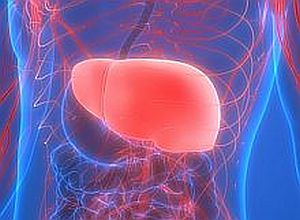A review article authored by a researcher at the Translational Genomics Research Institute (TGen), an affiliate of City of Hope, suggests that following menopause, women are at higher risk for developing non-alcoholic fatty liver disease (NAFLD), a chronic condition caused by the build-up of excess fat in the liver not caused by alcohol.
NAFLD is the most common cause of liver damage, and can lead to liver cirrhosis and death. It also is one of the leading indicators for liver transplants. And, it is common, affecting nearly 1 in 4 people across the globe. It often is associated with obesity, abnormally high amounts of lipids in the blood, and type 2 diabetes.
In the US, the number of NAFLD cases is expected to grow to more than 100m within the next decade. Already, the total annual costs among Americans is estimated at $292bn. “Even without taking into consideration the indirect costs of the disease, such as lost work-related productivity, it is clear that NAFLD places a substantial burden on the US healthcare system,” said Dr Johanna DiStefano, a professor and head of TGen’s Diabetes and Fibrotic Disease Unit, and the study’s senior author.
DiStefano’s review of more than 60 epidemiological, clinical and experimental studies suggests that the risk of NAFLD is greater among postmenopausal women than pre-menopausal women. Menopause is the time when women are no longer able to have children, most often after age 45. During menopause, a woman's ovaries stop producing the hormones oestrogen and progesterone. Women reach menopause when they have not had a period for one year.
Significantly, the level of an endocrine hormone called oestradiol, or E2, which is produced by the ovaries, declines significantly following menopause. E2 is the major female sex hormone involved in the regulation of the oestrous and menstrual female reproductive cycles.
“It is likely that the loss of protection conferred by oestrogens, combined with other factors, underlie the increased NAFLD risk in post-menopausal women,” DiStefano said.
NAFLD can progress to a more dangerous condition called non-alcoholic steatohepatitis (NASH), which indicates there is both inflammation and liver cell damage, along with fat in the liver. The number of NASH cases in the US also is expected to climb to a projected 27m by 2030. Among women, NASH is now the leading indication for liver transplantation, which is the most effective treatment strategy against NASH, though NAFLD recurrence in transplant patients is high.
“The mortality rate is rising among women with NAFLD, and more are dying from cirrhosis, suggesting that many women have NASH, rather than just NAFLD,” DiStefano said.
The review also suggests that normal-weight women with lipid, glucose and insulin levels within normal ranges are at low risk for developing NAFLD.
“Efforts to emphasize healthy diet and regular physical activity should be urged in middle-aged women as they approach menopause to prevent the development of NAFLD,” DiStefano said.
In addition, post-menopausal women may potentially benefit from treatment options, such as hormone replacement therapy (HRT). However, the effects of different hormone combinations, including the start of therapy, the duration of therapy, dosages and even how the treatments are administered “represent a critical gap in clinical research,” according to the review.
“Clinical studies with focused outcomes are necessary to determine if postmenopausal hormonal manipulation or other treatments can prevent or treat NAFLD in at-risk women,” DiStefano said.
Abstract
NAFLD prevalence in women is increasing worldwide. Women of reproductive age have lower rates of NAFLD compared to men; however, this protection is lost following the menopausal transition when NAFLD prevalence in postmenopausal women becomes similar to or surpasses that in age-matched male counterparts. Ongoing epidemiological, clinical, and experimental studies indicate greater NAFLD risk and higher rates of severe hepatic fibrosis in postmenopausal women relative to premenopausal women, and that older women with NAFLD experience greater mortality than men. Investigations involving ovariectomized animal models demonstrate a causal relationship between estrogen deficiency and heightened susceptibility to the development of fatty liver and steatohepatitis, although dietary factors may exacerbate this complex relationship. The accumulated findings suggest that a better understanding of the interplay among menopausal status, metabolic comorbidities, and sex steroids in NAFLD pathogenesis is needed. Further, the mechanisms underlying the difference in NAFLD risk between postmenopausal and premenopausal women remain incompletely understood. The goals of this review are to summarize studies of NAFLD risk in postmenopausal women, discuss results from animal models of estrogen deficiency, and explore the development of NAFD within the context of altered sex hormone profiles resulting from the menopausal transition. Potential implications for the prevention, diagnosis, and treatment of NAFLD in this relatively understudied cohort are also addressed.
Authors
Johanna K DiStefano
[link url="https://www.tgen.org/news/2020/august/14/tgen-review-shows-postmenopausal-women-risk-nafld/"]TGen material[/link]
[link url="https://academic.oup.com/endo/advance-article-abstract/doi/10.1210/endocr/bqaa134/5890353"]Endocrinology abstract[/link]

